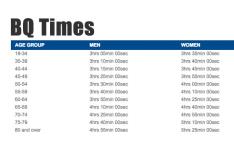
With spring around the corner, long distance runners around the globe are in the process of choosing which races they want to target. Unlike "shorter" distance races, such as 5Ks and 10Ks, longer efforts like half and full marathons require more planning, both in terms of your training and the logistics associated with the event as well. This year, before selecting your target race, consider a handful of key factors that will make a great race day experience more likely to happen.
Topography
At this year's Chicago Marathon I stopped to speak to a group of club runners a few hours after the race. Having trained in the hills of eastern Kentucky for most of their Chicago build up, three of them in particular were surprised that they were ill equipped to deal with Chicago's pancake flat course, devoid of any changes in the mechanics and impact seen in hillier courses. In short, they were so used to training over rolling hills-—with its constant changes in braking and acceleration—that the identical muscle firing pattern for four-plus hours experienced at Chicago made the latter stages the race quite difficult. Choose a half marathon or marathon run on the type of topography you can reasonably replicate in your own day-to-day training. Do you live in western Kansas? Perhaps the Grandfather Mountain Marathon in Boone, North Carolina (considered one of the hilliest in the lower 48), isn't the best fit unless you can utilize bridges or a treadmill to mimic the ups and downs. Are you from northern Maine? Perhaps the NYC Marathon, with its consistent rolling hills, is more to your topographical liking with its bridges creating a similar up and down course.
Weather
Finding a half or full marathon under "ideal" conditions has become increasingly difficult as we are now seeing warmer temperatures earlier in the spring and later in the fall. Even races in late October and November are now commonly seeing morning starting temperatures in the 60s and low 70s. When selecting which race you'd like to run, opt for one with weather patterns suited both to your strengths and in conditions for which you've prepared. As athletes, we all have weather to which we are better suited. Do you struggle with heat? Try as best as you can to find a race with cooler, dryer conditions, even if it means traveling a bit father for the effort. Do you perform well in warmer, more humid conditions? Look for an east coast event in late spring or early fall. And while no planning can guarantee the weather you desire (think Boston 2018), as coaches we also recommend preparing for weather outside your comfort zone. Here at ZAP we go out of our way to overdress by a layer or two when prepping for spring and fall marathons in the event the race turns out to be a hot one.
Race Size
Like marathon runners, marathon races come in all sizes. For many long distance runners, the larger marathon majors (Tokyo, NYC, Berlin, London, Chicago, Boston) and races of similar size—complete with much fanfare and hoopla—is appealing to many. Some runners, myself included, prefer a smaller- or medium-sized event (500 to 4,000 runners) in which runners typically experience fewer hassles associated with race day congestion. Additionally, large races generally require runners to wade through large expos for bib pickup and have packed starting corrals on race day, forcing athletes to abbreviate or forgo entirely their warm up routine. Whatever your taste, be sure to select races that fit your "size" personality as well.
Your Primary Goal
Before you look at the size of the race, the type of weather you are looking for or even the race's topography, you should ask yourself one question that will make your race decision that much easier: What is your purpose for the race? Is your primary intention of the chosen race experience or performance? If it's performance (aka times), find the fastest course you can, and find one that will be the least stressful to you in terms of both its size of the event, as well one with the better historical chances for ideal weather. If the half marathon or marathon distance race you choose is primarily about experience, any of the race qualities can be applied through the spectrum of enjoyment. And while enjoyment and performance are by no means mutually exclusive, knowing where your goals lie can help you make an informed decision.
READ THIS NEXT: A Training Schedule for Marathon Beginners
Get ACTIVE on the Go


Couch to 5K®
The best way to get new runners off the couch and across the finish line of their first 5K.
Available for iOS | Android







Discuss This Article